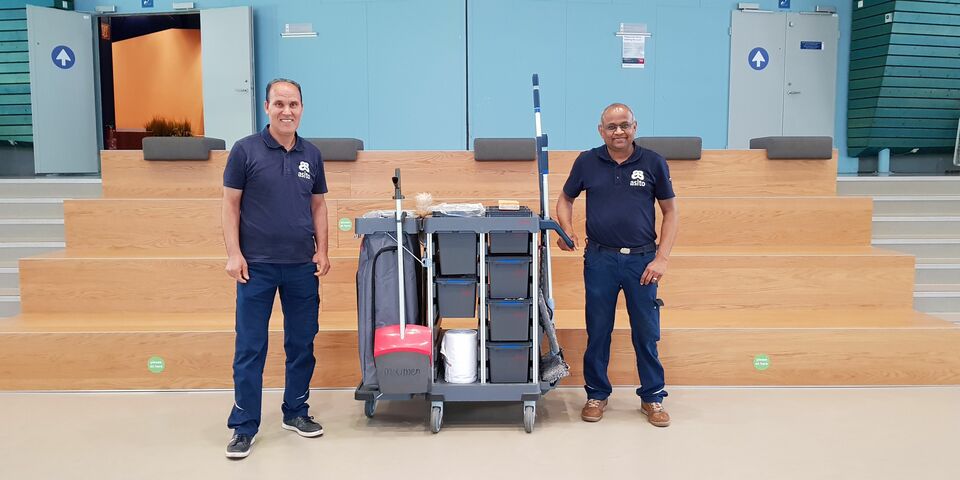TU/e cleaners helped out in a hospital during COVID-19 crisis
You could say that it’s a forgotten story from the early days of the corona pandemic. One year ago, some eight Asito employees who work as cleaners at TU/e spent a considerable time cleaning in a hospital and a nursing home. Two of them talked to Cursor about the work they did and how they experienced it. “I mopped the floors so hard that my arm started to hurt.”
When the university decided in March 2020 to send students and staff members home and to move all teaching activities online, those who under normal circumstances are responsible for feeding everyone and for cleaning TU/e’s work places suffered equally dramatic consequences. The catering service suffered the most serious blow: a significant part of the catering staff had to be fired because the TU/e canteens had to shut down for a long period of time and because all events scheduled to take place on the campus were cancelled.
However, the cleaners at TU/e also suffered consequences. Asito, the cleaning company that won the procurement contract for cleaning services at TU/e in 2019, needed to find a way during those first months to keep its personnel at work. After all, there was much less cleaning to do now that the university had closed down. Marloes van Geffen, coordinator at Asito, says that it was necessary to switch fast in those early days of the pandemic. “We saw peak workloads in the hospitals and nursing homes for which we also provide personnel. At the same time, we saw a strongly reduced workload at institutions like TU/e. And so, we started to look for people who wanted to help out, so that we could meet the most urgent needs at hospitals and nursing homes.”
Cure and Care
John Jagroe and Moumen Khatiri, who have been working at TU/e for 22 and 8 years respectively, spent the months of April and May 2020 working in the Jeroen Bosch Hospital. Jagroe: “We had taken the Cure and Care courses at Asito just the week before. These courses focus specifically on cleaning tasks at hospitals and nursing homes. Moumen and I could directly put to use our recently acquired knowledge. In the hospital, we were both assigned a buddy who showed how the work had to be done in a corona ward. Naturally, we had to wear protective clothing, a face mask and safety goggles.”
Both of them had to get used to working in those clothes and under such strict conditions. “A face mask makes it a bit more difficult to breathe, and you never really get used to it,” Khatiri says. Practically everything had to be cleaned: the areas that needed to be disinfected first with some sort of vaporizing device (“the smoke detectors had to be covered with tape first”), the beds (“we used a wonderfully scented soap-like substance for that”), the wheelchairs, the doorknobs and even the power sockets.
“It’s was a different way of working than what we are used to at the university,” Jagroe says. “But as cleaners we soon felt part of the team of doctors and nurses. We had one common goal: providing patients with COVID-19 with the best possible care. Hospital personnel was very friendly and helpful, and we really felt the respect during those months for what we did.”
Severe conditions
They didn’t clean in areas where patients were lying hooked to ventilators. “That’s taking it one step further,” Asito coordinator Van Geffen says. “We don’t want our people to suffer any trauma from having to work under these severe conditions. We gave people a choice. Those who really didn’t want to work in a hospital or nursing home could choose to drive a van.”
Jagroe waited two weeks before he informed his family and friends about his new temporary job. “I had to get used to the idea myself first, and I wondered during those weeks how they would feel about it. Would they be scared? I eventually told everyone.” Khatiri talked about it with his wife and children, and he was always extremely careful with clothing and hygiene when he returned home.
Challenging experience
Looking back more than a year later, Jagroe says that the experience was both exciting and challenging. “There was much uncertainty at first, and you had to be careful to comply with every protocol.” Khatiri says that he mopped the floors so hard that his arm started to hurt. “Apparently, you work even harder there to make sure that everything has truly been cleaned.”
Colleagues at other support services paid them many compliments upon their return to TU/e for the work they did during those months in 2020. They’re not considering a definitive transfer to a hospital or nursing home. Jagroe: “I’ve been working at TU/e for 22 years now and I still like it here very much. But if the situation turns dire again, I’m always prepared to return temporarily.”
On the main photo Moumen Khatiri (left) en John Jagroe standing in their familiar working environment in the Auditorium.


Discussion